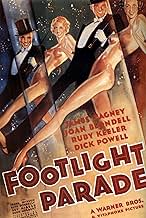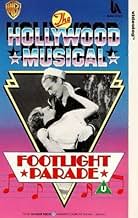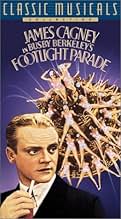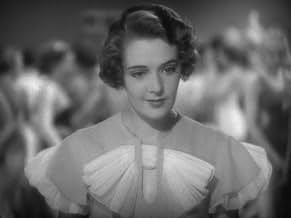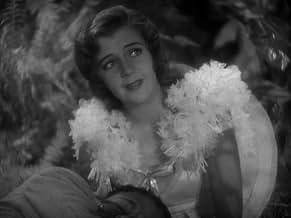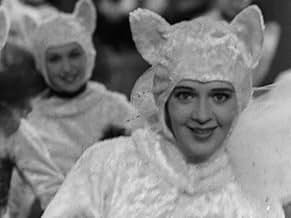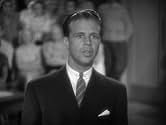Füge eine Handlung in deiner Sprache hinzuChester Kent struggles against time, romance, and a rival's spy to produce spectacular live "prologues" for movie houses.Chester Kent struggles against time, romance, and a rival's spy to produce spectacular live "prologues" for movie houses.Chester Kent struggles against time, romance, and a rival's spy to produce spectacular live "prologues" for movie houses.
- Auszeichnungen
- 3 wins total
- Chorus Girl
- (Nicht genannt)
- Chorus Girl
- (Nicht genannt)
Empfohlene Bewertungen
Sure, Warner Bros. tries to cover the orgy with the fig leaf of two cheerful innocents played by a sappy Dick Powell and a virginal Ruby Keeler. But it doesn't work, because everyone else gets in on the fun, including that human buzz-saw Jimmy Cagney and everyone's favorite sassy dame Joan Blondell. Director Lloyd Bacon proves too he knows what to do, giving us an eyeful of Blondell endlessly rolling and unrolling her hosiery, while the writers pepper the conversation with suggestive one-liners. Yeah, it's a great movie-- good enough to help bring down the heavy hand of censorship the following year, and put an end to damp dreams like "Beside a Waterfall". But not even the Watchdogs of Public Morality could stop Berkeley's deliriously suggestive pageantry that would live on at even that most repressed of studios, MGM. Sure, Astaire-Rogers may have been more graceful and a whole lot more chaste, no doubt producing more sheer polish-- still and all, don't let this unabashedly pagan celebration pass you by. As they say around the owl cage, it's a real hoot.
Cagney develops live musical prologues to be shown on stage at movie houses before the start of a film. (If you've seen the "Let's Go To The Movies" number in ANNIE you get the idea.) It's one catastrophe after another as Cagney tries to keep things running smoothly while staying a step ahead of the competition.
Joan Blondell is great as Cagney's secretary, who loves him more than he realizes. The solid cast also includes Busby Berkeley regulars Dick Powell and Ruby Keeler as a young new tenor and a secretary-turned- leading lady, respectively, with Frank McHugh as the perpetually worried dance instructor and Hugh Herbert as the morality adviser/censor. Lloyd Bacon directs the showbiz tale, with spectacular choreography by the inimitable Busby Berkeley.
I've seen this film's contemporaries (42ND STREET and GOLD DIGGERS OF 1933) and usually feel lukewarm toward these early musicals, but I found myself surprisingly receptive to FOOTLIGHT PARADE. I really liked Blondell's performance, with the romantic tension and snappy wit, and I could tolerate Keeler in her role. McHugh adds whiny comic relief and the script has some racy pre-Code touches. The film also benefits from James Cagney's screen presence. Cagney, best known for his gangster roles, demonstrates some dance steps in this rare musical appearance.
Berkeley choreographs a handful of routines (including an awkward cat- themed number), but saves the three biggest for the very end: "Honeymoon Hotel", "By A Waterfall", and "Shanghai Lil". As was often the case, the dance numbers are meant to be staged within the context of the story (a show within a show) and as was always the case, Berkeley choreographs cinematically, using camera movements, insert shots, and cuts that make no sense within the reality of the story. But his routines are meant for the moviegoers and they are awe-inspiring.
The water nymph routine will blow you away. I've seen my fair share of Busby Berkeley numbers, but the water nymph sequence may be his masterpiece. Did Berkeley invent synchronized swimming? I don't know, but he might as well have. There are unbelievable kaleidoscopic overhead shots as well as underwater choreography. I can't figure out how they did the shot of the swimmers in concentric rings, spinning in different directions, since the swimmers seemed to be lying still in the water. (Movie magic?) The more complex overhead shots are some of the most impressive visuals I've ever seen in a musical.
"Honeymoon Hotel" is a racy little number about couples spending their first night together in a hotel. Men in pajamas, women in negligees, bedrooms. There's a peculiar "child" that runs around causing mischief, but the scene has a neat larger-than-life dollhouse shot and a creative bit of stop-motion animation. "Shanghai Lil" follows a sailor through a crowded saloon in search of an elusive woman. There's a brawl, there are marching soldiers in formation, there's Ruby Keeler dolled up like a Chinese call girl, and there's Jimmy Cagney dancing and singing.
With a great cast and impressive dances, this is an enjoyable ride. Maybe the best of the early WB musicals.
The realistic, satirical treatment gives a fresh edge to the material and its pace and line delivery are breathtaking. To think that they only started making feature talking pictures 7 years before this! The brilliance of the dialogue cannot be matched anywhere today, especially considering that "realism" has taken over and engulfed contemporary cinema.
This film was made at a time when the Hayes code restricting content was being ignored and the result is a fresh, self-referential, critical and living cinema that spoke directly to contemporary audiences suffering through the depression and the general angst of the age. I'd recommend watching any film from this period, that is 1930-1935, for a vision of what popular cinema can potentially be.
Once more we have a film about a filmmaker fighting to stage a vision, here a preshow as opening act for the first talkies. He's a grunt, always storming in and out of rooms, yelling directions, now and then pausing to show the steps to the troupe or scream at a phone; but always fretting about new ideas to stage. He's played by James Cagney, whom we know best from tough-as-nails gangster roles. It's very apt casting. Cagney had many expressive talents, and a violent energy with the intuitive power to carry these into a performance.
But none of the ideas he comes up for the show seem like they've been very well thought out, they're all unfinished premises rushed with one foot out the door, so it's all a mystery how this strong-willed hack can give coherent shape to creative chaos. What kind of show he'll be able to put together. Money is staked on him, fortunes.
He's surrounded by three women, one for each number he's called to improvise. One is an ex-wife out for leeching money, another is his loyal secretary secretly in love. All three are fighting to seduce or be seduced, money is at stake again, and the art made with them.
It's all very enjoyable thus far, the rapid-fire banter and atmosphere of festive uproar. But it's not that it truly soars until we actually get to see on the stage how the various tribulations, that from our end so far seemed random and meaningless, were in fact shaping the vision that we get to see.
We drive back and forth around town to see these; the first number is about newly weds in the 'Honeymoon Hotel' with marriage slyly perverted as illicit sex that ends with bedroom eyes and mock happiness which we know will not last, and didn't for him, the other is a scene from everyday life on the street transformed on stage into the most gaudy spectacle with wood nymphs frolicking beneath cascading waters.
The third is the most stunning, because it substitutes for the internal processes that yield one happy end within another, both on the same stage. We knew our man was the author of these visions, the dreamer as it were, but was content so far to pull the strings from behind. Here an accident of fate forces him to get up on that stage and act out the part he was intuitively drawn to create: the number is about this man seeking out the woman of his dreams in a sort of smoky, semi-conscious stupor, and again the unforeseen circumstances - in this case, war - that keep love from them. Eventually he tricks both fates and us, the camera, to fulfill the dream.
So the happy end meant to take place in reality is pure Hollywood fiction, while the pure Hollywood fiction of the song and dance number reveals from machinations inside the soul a true purpose outside.
It is excellent stuff about the makings of images choreographed from the heart. Their power to articulate is this; art that reflects, salvages purpose from a life that appears incoherent, yet also reveals capricious fates of our own making that we have set in motion by simply living our part. Clearly this grunt could not have staged what he did, even with expert craft, if life around him had not seduced inspiration out of him.
Watching it again tonight, I was, however, struck yet once again by the genius of Busby Berkeley in staging the last three numbers, the "prologues." Most remarkable of a very remarkable trio for me is "Beside a waterfall." It just keeps building and building and building. Yes, of course, some of the shots of the women in the water are very erotic. It was 1933, after all, and before the Hayes Code. Berkeley and Warner Brothers understood that pretty women posed erotically had a real appeal to men,
------------------------------------
I watched the end of this movie again this morning. Perhaps I paid closer attention to this number this time, perhaps I was just in the right "mood." Either way, I marveled at the suggestiveness of so much of it. Those jets of water spurting up - I use the verb advisedly - between the swimming women's legs. All those shots of women opening and closing their legs. It was remarkably erotic on my 46" tv screen. What must it have been like in 1933 on huge movie theater screens in the era before multiplexes????
==========================================
But these erotic poses are not JUST erotic poses. The number keeps building and building and building. What will he do next, you keep wondering? Oh, that. But "that" is even more incredible than what has come before. By the time you get to the end of this number, you're exhausted, not just physically and erotically, but imaginatively as well. How could anyone have maintained and built on that suspense for 10 whole minutes? I can't tell you, but Berkeley did.
Third of the three prologues, "Shanghai Lil," is definitely not something that could have been filmed the same way just a year or two later when the Production Code was put in force. We see an opium den, a lot of prostitutes, at least one interracial couple, etc.
Having watched it again tonight, I will add that this is a strange "musical." There is almost no music for the first hour and a half. It's all in the three closing numbers. But what numbers!
Wusstest du schon
- WissenswertesFirst film where James Cagney dances - showing off his vaudeville and stage experience as a song-and-dance man. Cagney lobbied Warner Bros. to play this role. He would show off these talents to their fullest in Yankee Doodle Dandy (1942).
- PatzerAfter the "By A Waterfall" prologue ends, the film cuts to the audience giving an animated and thunderous applause, but in the balcony there is no applause or reaction. In fact, there is no movement whatsoever. They are perfectly still which indicates that a photo or painting was used for the balcony audience and then merged with the live theatre audience. The same photo/painting was also used for the "Shanghai Lil" balcony audience.
- Zitate
Nan Prescott: You scram, before I wrap a chair around your neck!
Vivian Rich: [Angrily] It's three o'clock in the morning - where do you want me to go?
[Nan starts to speak, but Vivian immediately cuts her off]
Vivian Rich: You cheap stenographer...
Nan Prescott: Outside, countess. As long as they've got sidewalks YOU'VE got a job.
[Shoves her out, gives her a swift kick in the rump, and slams the door behind her]
- Alternative VersionenThere is an Italian edition of this film on DVD, distributed by DNA srl, "VIVA LE DONNE! (1933) + AMORE IN OTTO LEZIONI (1936)" (2 Films on a single DVD), re-edited with the contribution of film historian Riccardo Cusin. This version is also available for streaming on some platforms.
- VerbindungenEdited into Busby Berkeley and the Gold Diggers (1969)
- SoundtracksA Vision of Salome
(1908) (uncredited)
Music by J. Bodewalt Lampe
Played during the prologue scene in the movie theater
Top-Auswahl
Details
- Erscheinungsdatum
- Herkunftsland
- Sprachen
- Auch bekannt als
- Chester übertrifft sich selbst
- Drehorte
- Produktionsfirma
- Weitere beteiligte Unternehmen bei IMDbPro anzeigen
Box Office
- Budget
- 703.000 $ (geschätzt)
- Weltweiter Bruttoertrag
- 276 $
- Laufzeit
- 1 Std. 44 Min.(104 min)
- Farbe
- Seitenverhältnis
- 1.37 : 1



